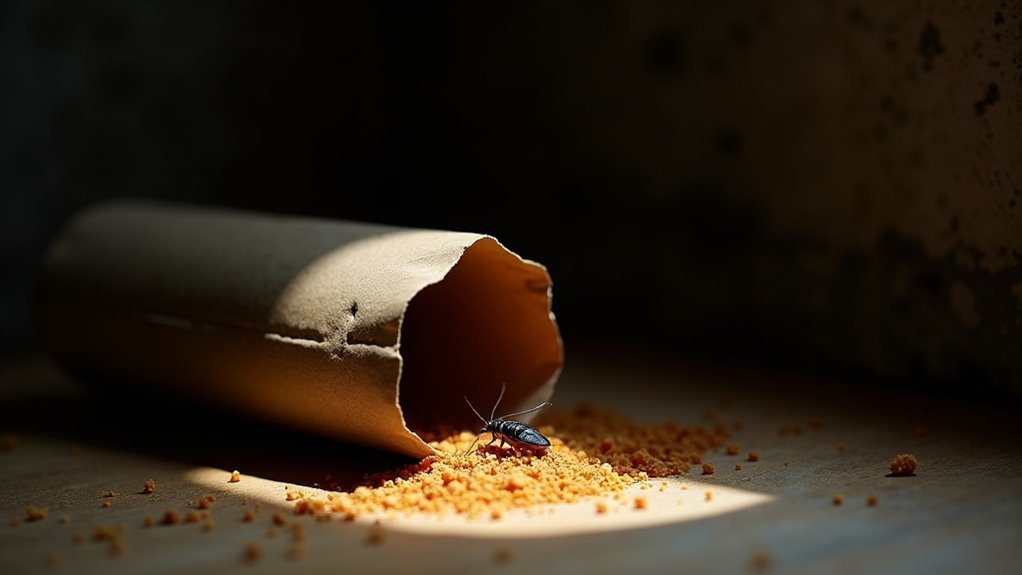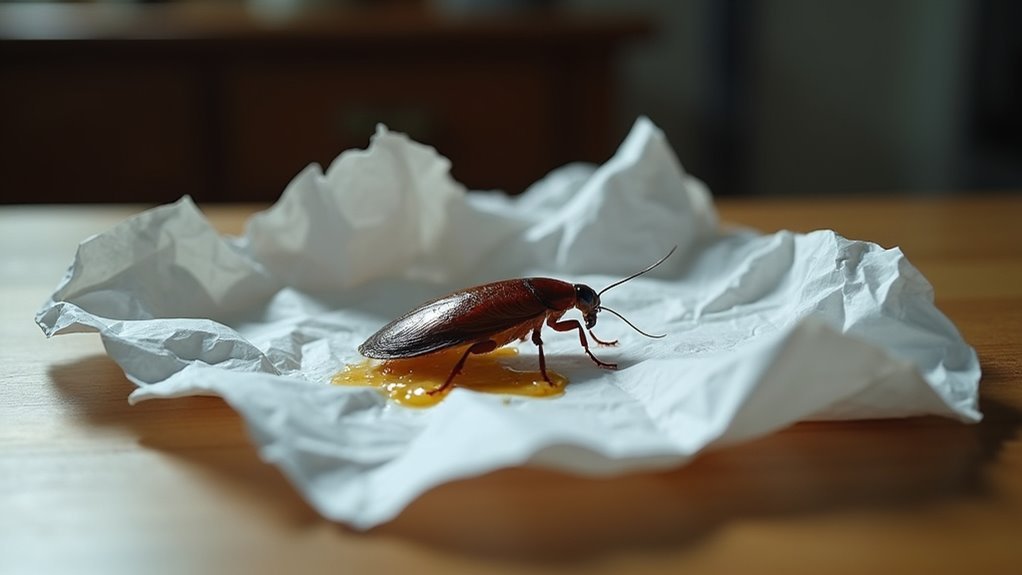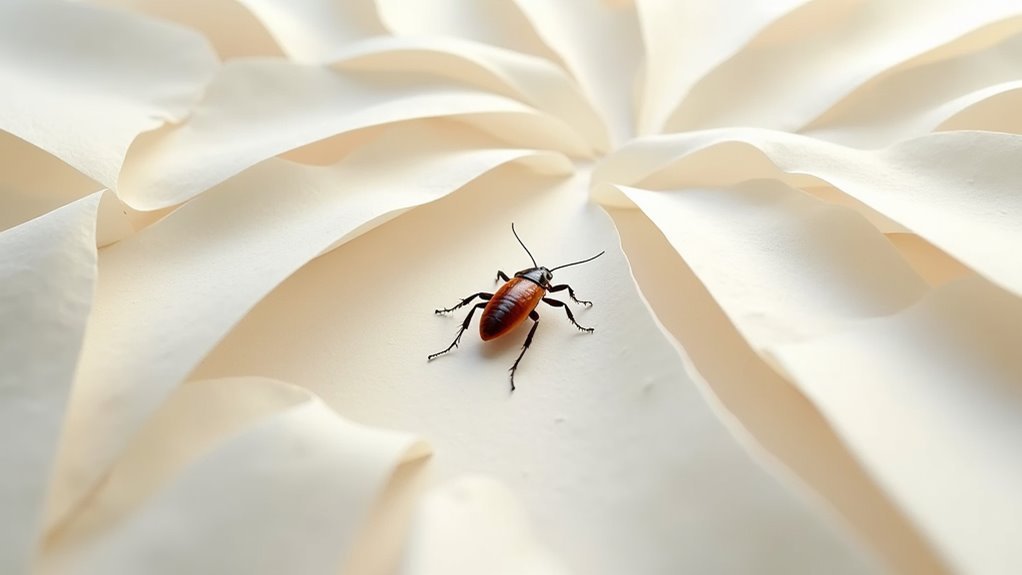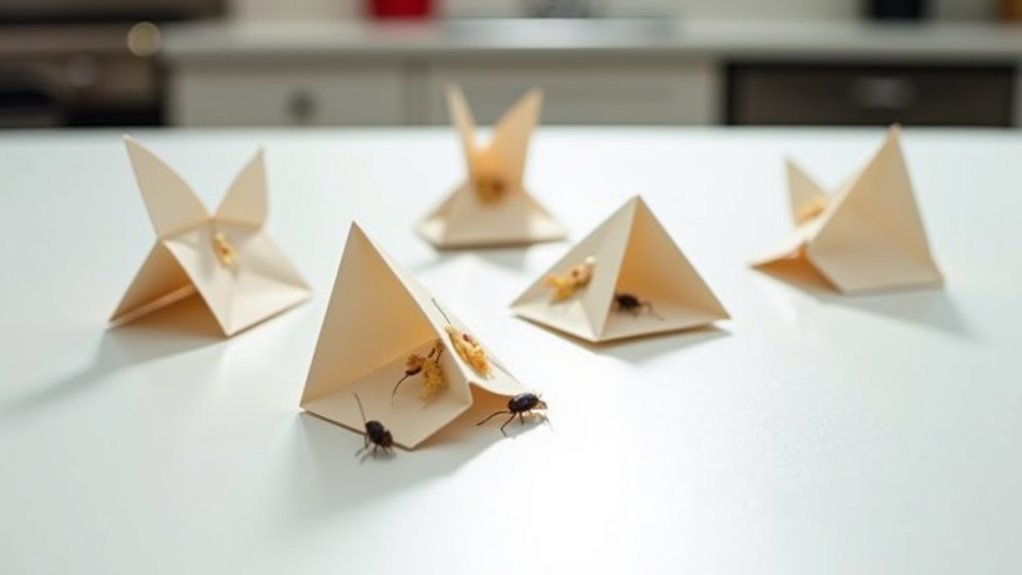You can create effective cockroach traps using simple paper materials found around your home. Try cardboard tube traps positioned horizontally in dark corners with bait inside, or use sticky paper sheets coated with adhesive near food storage areas. Crumpled newspaper creates attractive hiding spaces, while paper funnel traps provide controlled entry points that prevent escape. For high-traffic areas, construct multi-layer paper barriers with non-toxic adhesive. These techniques exploit cockroaches’ preference for confined, dark spaces and will help you discover even more strategic placement methods.
Paper Tube Trap Method for Dark Corner Placement

When cockroaches invade your home, you’ll find the paper tube trap method offers one of the simplest yet most effective solutions for capturing these persistent pests.
Start by selecting a cardboard tube from paper towels or toilet paper rolls. These insects are naturally attracted to dark, confined spaces, making proper placement essential for success.
Cockroaches seek out dark, narrow spaces naturally, which makes cardboard tubes from household paper products ideal trap materials when positioned strategically.
Position your paper tube trap horizontally in dark corners where cockroaches frequently travel. Apply bait inside using smelly substances like overripe fruit or peanut butter, which effectively lure them into the tube.
Make certain the trap won’t roll by securing it against walls or furniture.
Check the trap regularly every 24 hours to monitor captures and refresh bait as needed.
Remove captured cockroaches by discarding it in sealed plastic bags.
Sticky Paper Sheet Technique With Adhesive Coating
Since cockroaches can’t resist sticky surfaces once they make contact, you’ll discover that adhesive-based paper sheets provide an incredibly reliable trapping method.
These sticky traps work by coating thick cardboard with strong adhesive that maintains its tackiness over time. Place traps strategically in dark corners, behind appliances, and near food storage areas where cockroach infestation typically occurs.
To enhance the trap’s attractiveness, add small amounts of overripe fruit or peanut butter as a bait station. This lures roaches directly onto the adhesive surface.
You’ll need to trap cockroaches consistently by performing a regular check of each trap’s condition. When roaches get caught, dispose of trapped roaches by sealing the entire sticky paper in plastic bags before discarding to prevent escapes.
Crumpled Paper Roach Trapping Technique

The crumpled paper technique offers a surprisingly effective way to trap cockroaches using nothing more than a sheet of newspaper or similar paper.
You’ll create a loose ball that forms an attractive hiding space for these pests. Place your crumpled paper in dark areas where cockroaches frequent, such as under sinks or behind appliances.
Since cockroaches are nocturnal, check your traps every few hours or after overnight periods for maximum capture rates.
This trapping technique uses common household materials, making it completely non-toxic and safe around children and pets.
Once you’ve caught roaches, immediately seal the paper in a plastic bag for proper disposal, preventing any escapes while eliminating the pests.
Paper Funnel Trap Design for Enhanced Capture
Paper funnel traps represent a significant upgrade from basic crumpled paper methods, offering controlled entry points that prevent cockroach escapes once they’ve entered.
To construct your paper funnel trap, roll stiff paper into a cone shape with an opening wide enough for roaches to enter but too narrow for escape. Place effective bait like overripe fruit or sugar-water at the bottom to attract cockroaches into the trap.
Position your trap in dark areas where roaches hide, such as under sinks or behind appliances. Secure the funnel upright with tape or place it inside a container for stability.
Check trap every 24-48 hours to dispose of roaches and refresh bait. This method provides superior cockroach control through strategic capture design.
Multi-Layer Paper Barrier System for High-Traffic Areas

While funnel traps excel at containing individual cockroaches, high-traffic areas require broader coverage to intercept roaches moving through common pathways.
You’ll create a multi-layer paper barrier by stacking several sheets and coating them with non-toxic adhesive or sticky substance. This trap effectively catches cockroaches as they navigate through the barrier.
Position your paper barrier near entry points where you’ve noticed visible cockroach activity, like under sinks or behind appliances. The layered design maximizes interception in high-traffic areas where roaches frequently travel.
Enhance effectiveness by placing bait such as sugar or food scraps near the barrier to attract cockroaches.
Check and replace paper layers regularly to maintain adhesion, disposing of trapped roaches promptly to prevent contamination.
Frequently Asked Questions
What Is the Easiest Way to Catch Roaches?
You’ll catch roaches easiest by placing sticky paper traps coated with honey in dark corners where they hide. Add sweet bait like banana peels, check regularly, and replace traps frequently for best results.
How to Make Homemade Roach Traps?
You can create effective homemade roach traps by rolling paper into tubes, coating the inside with sticky adhesive, adding bait like peanut butter, and placing them where you’ve spotted cockroaches frequently.
Do Roaches Hide in Paper Bags?
Yes, roaches definitely hide in paper bags. They’re attracted to the cellulose, can chew through easily, and find dark shelter inside. You’ll want to store food in sealed containers instead.
What Food Is Irresistible to Cockroaches?
You’ll find cockroaches can’t resist sweet foods like honey and sugar water, oily baits such as peanut butter, fermented items like beer, and starchy foods including bread and pasta crumbs.
In Summary
You’ve got five effective paper trap methods to tackle your cockroach problem without expensive products. Whether you’re targeting dark corners with tube traps, using sticky sheets for open areas, or setting up funnel designs for maximum capture, these DIY solutions work. Don’t forget the crumpled paper technique for quick fixes and multi-layer barriers for heavy infestations. Start with the method that fits your space and available materials best.





Leave a Reply